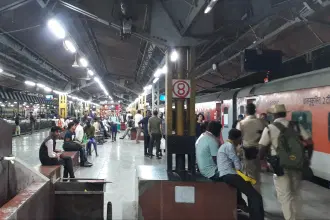Announcements
The Festival of Democracy and the Temple of Vacuum
Praveen Patil
Oct 15, 2012, 11:41 PM | Updated Apr 29, 2016, 02:07 PM IST
Save & read from anywhere!
Bookmark stories for easy access on any device or the Swarajya app.


Launch of ECRI (Elections at Centre-Right India)
October 25th, 1951, Chini Tehsil, Kinnaur District, Himachal Pradesh:
India’s tryst with democracy began in this small, beautiful, village of Chini in Himachal Pradesh, for this is where the first votes were cast in independent India’s 1st general elections on 25th October 1951. The first general elections were not just to elect parliamentarians to govern the republic of India but also to elect state assemblies. A total of 171747300 registered voters were eligible to vote in these elections, but only 15% of them were literate, so each party/candidate was allotted a symbol in order to help the illiterate participate in the process of democracy. The first general elections were a long drawn out affair and lasted a full four months before they were completed on 21st February 1952. After this long process, the Congress party emerged victorious with a tally of 364 parliamentary seats in a house of 489, while also winning in all the state assemblies.
Since that eventful day in 1951, India has seen tens of hundreds of elections in the last 65 years and the festival of democracy has been a resounding success, despite of individual failures. Right from 1951, electoral politics has been a headline creating event, with the newspapers, radio, television and all other forms of media covering the events thoroughly. In the initial decades when long drawn out elections were the norm, print media analysis and election bulletins on All India Radio – Akashvani, were the most sought after mass mediums for election related news and information. Then in 1984, the state run Doordarshan, the only television channel of that era, for the first time broadcast live election coverage and analysis, giving birth to the carrier of Prannoy Roy, a trained psephologist – who correctly predicted the landslide for the Congress party in 1984.
Over the years as the number of television channels and print publications multiplied, election coverage and analysis has emerged as a big business in the post liberalization era. The mushrooming of various Television News Channels, Newspapers & Magazines of both the print and online kind haven’t really made the big difference that they should have possibly made to the Delhi-centric, left-liberal narrative of India’s electoral analysis & coverage. Even a cursory comparison with the pre-liberalization era and the present day scenario, in terms of mainstream Indian media, gives us just an additional number of personalities rather than viewpoints. They have simply multiplied in numbers and adapted newer platforms without changing either the content or the narrative.
In the last decade or so, “paid news” has infested India’s body politic as a disease, especially in terms of electoral politics during elections. It is a well-known fact that media houses get paid by political parties and candidates for favourable election coverage. Neutrality, the hallmark of the fourth estate, has been compromised and there is a large vacuum in India as far as election coverage and analysis is concerned.
It is in this milieu, that after more than 60 years when those first votes were cast in India’s first general elections in 1951 in the Chini Tehsil of Himachal Pradesh, that CRI has decided to step into that vacuum – incidentally, Himachal Pradesh is once again facing an election at the fag-end of 2012 and ECRI will begin its election coverage with the hill state. ECRI is an endeavour to give the most comprehensive election analysis on this side of the Atlantic, by liberating electoral politics from the elite left-libbers and delivering it to common netizens; this is true democracy unfolding on a computer or mobile device near you. ECRI requests community participation from all readers in analysing elections; there would be a district specific analysis of elections and reader/user contribution would be at the heart of this enterprise.
(Image Courtesy – http://indiacurrentaffairs.org/)
Analyst of Indian electoral politics and associated economics with a right-of-centre perspective.





